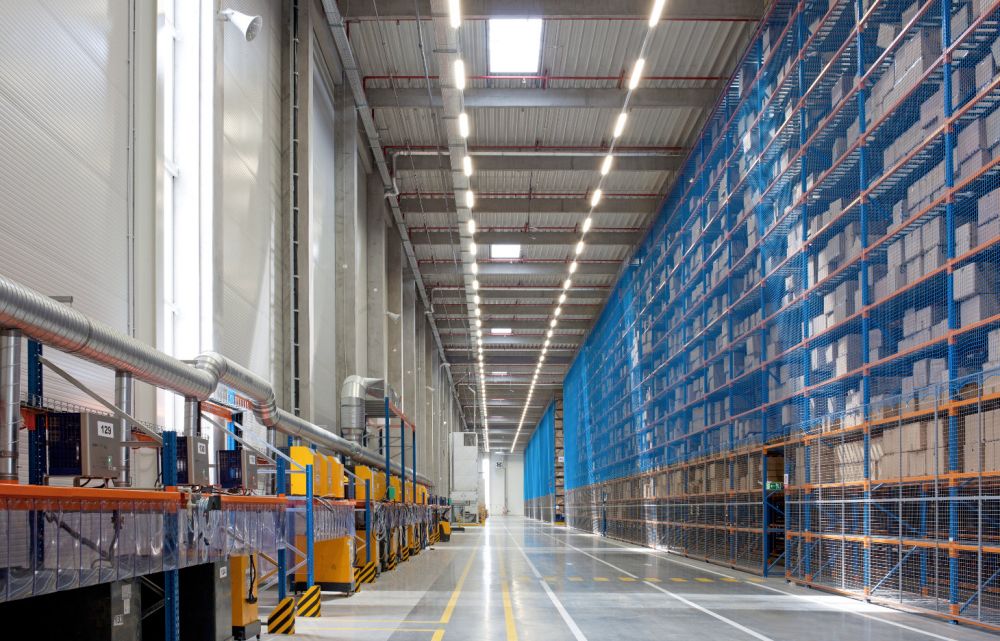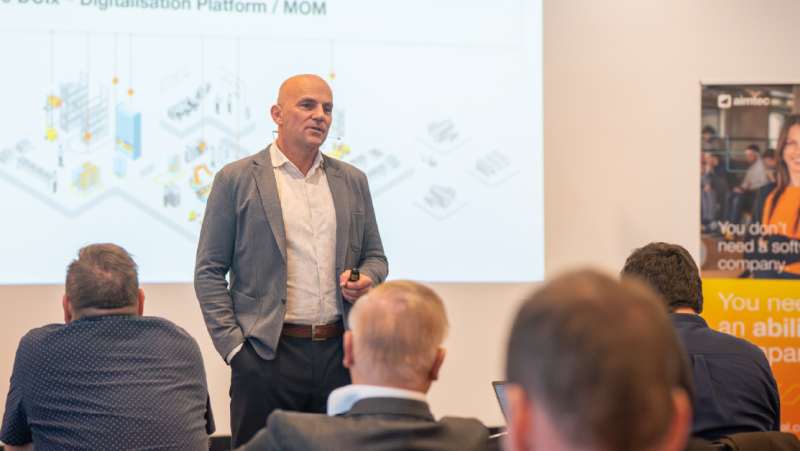How to Automate Warehouse Processes with VNA: The General Prerequisites
- Automation
- Article
More and more often warehouse halls contain VNA (Very Narrow Aisle) forklifts that zip through aisles all on their own, or in semi-automatic mode. But before they can do that, you need to integrate them into their surroundings properly. Unless you want VNA to stand for “Very Nasty Automation,” you need to make sure not to underestimate preparations. How can you prepare your warehouse and processes for this expansion of your fleet? We have a few tips on how to approach it.
There are basically two kinds of companies here: the first plan automation as a whole and involve every supplier in the project from the start. When it comes to VNA integration, they plan the warehouse layout in advance, they think over what types of forklifts to acquire, and they invite in the system integrator. The second type takes the opposite approach. They start by picking technologies and designing their warehouse, and only then do they invite in the WMS supplier to put it all into motion. Both scenarios can work successfully, but you have to be well-prepared.
“Our experience as a system integrator in dozens of projects for integrating a VNA into the organism called a warehouse is that if you approach everything holistically right from the start, your implementation will be more successful. But the other route doesn’t have to be bad either, and circumstances often demand it. However, be prepared for the fact that you may have to “bend” your company’s approaches, and that your pre-picked technologies may be insufficient for the warehouse you’ve proposed, or may even lay unused.”
In this kind of automation you won’t use a traditional WMS
Projects for VNA hardware control deployment represent a higher degree of system control than is seen in ordinary WMS deployments. With automated forklifts involved, a Warehouse Management System must additionally encompass processes for controlling this hardware, and this turns into a WCS: a Warehouse Control System. Thus right from the start you need to ask yourself questions that are unpleasant, yet essential to keep your project from swiftly going sour. Because nobody wants that. So ask yourself and your suppliers:
- Will the technologies be able to handle the given process themselves, or is user input needed?
- To what degree is user intervention necessary?
- What hardware conditions need to be specified?
- Will a greater degree of automation bring the most efficiency, or will a mere partial adaptation of processes be enough?
- Will you be able to make maximum use of the technology at your warehouse?

When implementing VNAs, check also the technical state of your building. Photo: P3.
Prepare the hall, project and team
Even if your initial enthusiasm may spur you to choose the new forklifts quickly, try stopping for a moment before their deployment and going over whether you’re truly prepared for them. To that end, we’ve prepared a list of the most important areas to focus on in order for your VNA system to be an effective helper, not just a necessary evil. Focus on these three factors: the hall, the project and the team.
The technical preparations at your site
If you’re considering deploying VNA forklifts with any degree of automation at your warehouse, first verify how your warehouse stands. Literally and figuratively.
The floor
The movements of VNA forklifts – “VNAs” – are very touchy when it comes to the state of the floor.
If it’s uneven, a VNA may fall out of its guidance track (e.g. its induction track) in certain parts of the aisle and stop in mid-process. After that the VNA’s position may not correspond to its predefined coordinates (defined by the warehouse map), and this may cause imprecisions during put-away and removal from storage. In short, the VNA will not be docked exactly at the pallet that it should be loading, or in the position where it is to automatically remove the pallet from storage.
“In most of the halls where we’ve introduced automation, we’ve had to deal with supplementary floor adjustments (grinding, levelling etc.). That can mean no small added cost for a project.”
Wifi
Thorough coverage of the warehouse with a wifi network might seem like a simple task, but people often underestimate it. In reality it can fundamentally affect the outcome of the whole project.
In logistics the main pressure is on speed of picking, so wifi requirements are all about fast communication between the user (the touch terminal) and the forklift. The network must cover every last corner where you’re planning to send a VNA. Otherwise you can encounter outages, which will slow down the entire picking process.
“The new forklifts’ operators will accept them more if they’re easy to control. During network outages, communication with the VNA will drop as well, and that can lead to negative perceptions of the new technologies.”
Preparing the automation project – the warehouse
No matter whether we’re talking about semi-automatic VNAs added to existing processes or the construction of a new automated warehouse, before you make your decision on the details, frills and trills of your individual VNA models, think over the entire project and above all the scope of integration and its influence on its surroundings, the storage method, and the type of handing units.
The scope of integration
Projects that only involve integrating VNA forklifts into a WMS are quite rare. Usually companies take on more comprehensive integration, where besides just VNA forklifts, follow-on technologies such as conveyors, semaphores, scales etc. are used as well. However, in this situation the integrator has to take into account many more input parameters, because there is a far greater pressure to control all of the technologies in a way that ensures that the individual tasks hook into each other well and that the process is free of delays (and thus financial losses). In this situation you can’t tackle every technology in your warehouse separately; you need to take into account the whole warehouse as one unit.
The storage method
Your racks will influence how your technologies are controlled as well. Take for example their depth – are your racks single-deep or double-deep?
For double-deep racks, you need to think about the overall composition of the processes that will take place there. Double-deep racks give large space savings, but you do need to provide for additional transports in cases where you need to remove a pallet from storage in the rear position. It will be necessary to free up the front position and transfer the pallet that’s in it to a different position. This will influence the WCS design and the process composition: the software will have to seek another location that is suitable for the front pallet while respecting the storage logic. After this it will send a command to the VNA for re-storing the front pallet, and only then the command for transporting out the rear pallet. Additionally, when configuring the system you will need to provide for a warehouse occupancy percentage that ensures sufficient free positions for these types of transfers. Because of this, we strongly recommend configuring a high degree of automation and minimising user decision-making. This won’t just save labour – it will speed up picking and prevent errors.
Handling units and the picking method
In every VNA deployment project, the type of handling unit is a decisive factor. Will you be picking units, boxes or always entire pallets? The type of handling unit affects not just the choice of technologies (the type of VNA), but also the composition of the processes to configure for controlling them.
If you will always be transporting entire pallets, the process can be automated fully. If you will be removing boxes or individual units of materials from storage, there will always be a need for human intervention. Without it, the VNA cannot determine whether the process of removal from storage has been completed. The operator must physically remove the units from the position and place them onto the VNA pallet and subsequently enter or confirm the amount removed using the forklift terminal or a scanner. This signals to the WCS that the removal process is complete. The system closes the task and sends a further command to the VNA. This process tends to be more complex in terms of the design of the control system’s configuration.
“Think about the weight of the handling units that the VNA will be transporting. Mass has an effect on the speed of the forklift’s movement, especially at large heights. In short, the heavier the handling unit and the higher up the VNA is manipulating it, the slower it will move. You have to account for this when designing your processes so as to ensure the warehouse throughput level demanded by your picking requirements.”
Preparing the automation project – the people
Your internal team is key for automation – we’ve already written about this. But with a VNA it’s about not just the project management team, but also the VNA operators.
Operators/users
When configuring the processes and deciding what degree of automation to use, you should also keep in mind the team you have available for logistics. The important points are their turnover and technical skill. If you have minimal turnover and you have responsible and reliable end-users at the warehouse, you can take the liberty of a certain looseness in the processes you set up. That will enable you to respond better to changes and non-standard situations.
But if you do have to deal with turnover, we recommend a greater degree of automation, as this will make training new workers much faster. Essentially the point is for user intervention in the process to be zero or minimal – just at the level of checking.
“When implementing the project, you can run into sabotage on the part of your workers. We’ve experienced a case where the process was set up in a way that let users intervene in the process of guided storage and decide on the target location, and in some cases change it. One user deliberately suspended guided storage on the VNA and, via manual guidance, placed a pallet in a different position than the one the system had guided them to. Alongside HR measures, the process had to be changed so that users could no longer intervene in it.”
Overall project coordination
One of the hardest tasks in an automation project, and one impacting upon its success, is the overall coordination of activities. In projects for the supplying and controlling of technologies, activities by multiple suppliers are interwoven, and therefore you must time and synchronise the activities of all implementation teams correctly. Otherwise you will often see slippage of the entire project.
If slippage does occur, one way out is to “phase” the project – in short to break it into individual phases and processes and roll out the processes and technologies in stages. However, you should then expect to need extra effort and costs for change procedures.
That’s enough on the broader context in which the VNAs will be situated. In our second part, we’ll be looking at the details to take on and consider for the forklifts themselves.
Share article
Top stories from logistics, production and IT.
Subscribe to Aimtec Insights
By registering, you agree to the processing of your personal data by Aimtec as described in the Privacy policy.
Get top stories and articles
from Logistics, Production and IT.
Subscribe to Aimtec Insights
By registering, you agree to the processing of your personal data by Aimtec as described in the Privacy policy.








